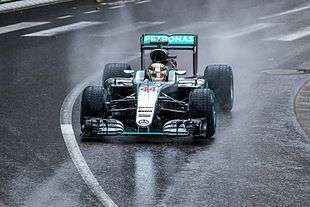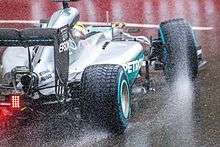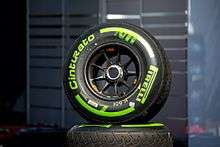Rain tyre
Rain tyres or Wet tyres ("tires" in American English, commonly shortened to wets) are special tyres used in motorsport in wet weather as opposed to a slick tyre used in dry conditions. They are very similar in many ways to the tyres found on normal road cars.[1]

Rain tyres are formally banned in all-NASCAR, all-ARCA and all-INDYCAR sanctioned tournaments respectively only for all oval tracks due to safety concerns.
Structure
Rain tyres have a specially designed structure making them better adapted for their application than any other tyres. However, not all rain tyres obey the same design principles. Certain factors need to be taken into account when designing a good rain tyre, such as the:
- speed of the car
- weight of the car
- power of the car
- lifespan of the tyre
Grooves

Rain tyres are cut or moulded with patterned grooves or tread in them. This allows the tyre to quickly displace the water between the ground and the rubber on the tyre. If this water is not displaced, the car will experience an effect known as hydroplaning as the rubber will not be in contact with the ground. These grooves do not help the car grip contrary to popular belief, however if these grooves are too shallow, the grip will be impaired in wet conditions as the rubber will not be able to make good contact with the ground. The patterns are designed to displace water as quickly as possible to the edges of the tyre or into specially cut channels in the centre of the tyre. Not all groove patterns are the same. Optimal patterns depend on the car and the conditions. The grooves are also designed to generate heat when lateral forces are applied to the tyre.
Rubber
Rain tyres are also made from softer rubber compounds to help the car grip in the slippery conditions and to build up heat in the tyre. These tyres are so soft that running them on a dry track would cause them to deteriorate within minutes. Softer rubber means that the rubber contains more oils and other chemicals which cause a racing tyre to become sticky when it is hot. The softer a tyre, the stickier it becomes, and conversely with hard tyres.
When rain has stopped falling, and a track is in the process of drying, it is not unusual to see drivers intentionally driving through wet puddles and damp portions of the course, in order to cool the rubber and stave off tyre deterioration. As soon as possible, drivers will revert to slick tyres to maintain competitive speeds.
Shape
Sometimes rain tyres are designed to have a smaller diameter than their dry counterparts. This means that the wheel spins faster and more water is thrown off the tyre by overcoming centripetal force. Some rain tyres are also narrower than the dry counterparts. This smaller "footprint" reduces the chances of hydroplaning.
Intermediate tyres

Some racing series such as Formula One allow an intermediate (inter) tyre. This tyre is designed to be used in conditions too wet for slick tyres and too dry for wet tyres. They are made with rubber compounds slightly softer than slick tyres and are cut with grooves like the rain tyre but shallower to prevent excessive heat build up. Former Formula One tyre supplier Bridgestone referred to the "intermediate" tyre as the "wet" tyre, and to what are known as "full wets" as "monsoon tyres".
References
- McFadyen, Peter (2008). Motor Racing at Oulton Park in the 1970s. Veloce Publishing Ltd. ISBN 1-84584-164-6.